The Existing Situation
The 400m² workshop has no insulation and the workshop heating consisted of a single 24 kW oil fired warm air blower positioned in the back corner of the building. With a ridge height of 6.5m, the convection heater was unable to effectively heat the space and warm the mechanics as the heated air quickly rose towards the ceiling where it offered no thermal benefit. Only when the air cooled and lost its heating capability did it sink back towards the ground where it slightly raised the ambient temperature offering little or no real benefit to the occupants.
There was also a significant loss of heat and a cold draught every time the large sliding doors were opened to move the cars because the rising warm convection currents sucked in cold air from outside.
The Challenge of Workshop Heating
Due to the nature of the work only 40% of the floor area is occupied by the mechanics. Therefore, those working on the cars needed a form of heating which would warm them directly without wasting valuable energy attempting to heat the unoccupied areas. It was also important that the workshop heating should not escape each time the large sliding doors were opened.
Throughout the day mechanics use the Diagnostics Work Stations for approx. 20 minutes at a time. However, they are not in continuous use and only required heating when a mechanic is present. Effectively controlling the workshop heating was important to optimise the mechanics thermal comfort and to ensure as little energy as possible was consumed during its use. This was also a pre-requisite to obtaining grant funding (33%) from European Regional Development Fund through Low Carbon Workspaces, specifically given to enable small and medium sized businesses to improve the energy efficiency of their premises.
The Infrared Workshop Heating Solution
The principle of infrared heating is often used in buildings, such as industrial premises, with high ceilings. There are no heat losses between the heater and the mechanics/floor since infrared waves produced only create heat when they strike a surface. With infrared heating it is possible to direct the heat to where it is needed, in this case the mechanics and work areas around ramps which are in constant use. The ETHERMA EZ infrared heaters directly warm the mechanics and also provide zoned heating. This allows the areas around the ramps to be warmed prior to the staff starting work.
Precise control of an infrared heating system ensures occupancy comfort, saves operating costs and avoids wasting energy. To this end, the ETHERMA EZ heaters are controlled by a programmable thermostat mounted within the distribution board (to prevent unauthorised use) with a temperature probe located within the heating zone.
For the Diagnostics Work Station shortwave infrared heaters offered the ideal solution. These infrared heaters provide immediate spot heating and are therefore ideal for infrequently used areas where no surrounding heating is required. The Solamagic infrared heaters are individually controlled by electronic timers which give the user 20 minutes of heating before switching off automatically.
Infrared Workshop Heating Solution in Detail
Along the row of hydraulic ramps, four ETHERMA EZ 2 kW double panel infrared heaters were installed on the first purlin at a height of 3m with the 5th heater wall-mounted on the end wall. The five ETHERMA EZ Infrared Heaters create heating zones and are controlled by an ITR-80 Electronic thermostat. An external temperature sensor is used to monitor air temperature in the heating zone. The thermostat is set at 16°C and programmed to come on half an hour before the mechanics start work and turn off one hour before they finish.
Over the Diagnostic work bench and two lightly used ramps (total of 3 hours/day)‚ SOLAMAGIC Low Glare ECO+ 2000 heaters have been used. This short-wave infrared heater is designed for commercial use. It has a highly efficient reflector (ECO+), which optimizes the illuminated surface. The innovative ‘Solastar Heating System’ converts the maximum amount of energy to heat whilst simultaneously reducing the light emission by over 90% compared to conventional heating tubes, thus preventing uncomfortable retina burn to the eyes.
The SOLAMAGIC Low Glare ECO+ 2000 are controlled by a timer switch, not a thermostat, as they are used to provide spot-heating rather than ambient heating.
ETHERMA EZ Infrared Heaters Specification

- Voltage: 230, 400V
- Output: 800 – 3600W
- Max. element temp.: 340ºC
- Colour: Traffic white, RAL 9016; EZ-3600 galv. steel panel
- Mounting height: 2.5m – 9m
- Protection rating: IP 44
- Permanent connection
- Approval: SEMKO, CE compliant
SOLAMAGIC ECO+ Low Glare Infrared Heaters Specification

- Power: 2000 W
- Nominal voltage: 230V, 50/60 Hz
- Heating tube: Infrared halogen lamp
- Colour options: White, titanium, nano-anthracite
- Connection: Connector cable 180cm
- Assembly: Ceiling, wall, tripod
- Heated area: Up to 16m²
- Protection class: IP 24
- Certification: TÜV Nord
ITR-80 Electronic Thermostat

Electronic thermostat with digital display mounted within the distribution board to avoid tampering by unauthorised personnel. An external temperature sensor (can be up to 50m from distribution board) is used to monitor air temperature in the heating zone.






















